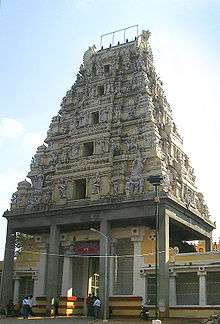Sri Dakshinamukha Nandi Tirtha Kalyani Kshetra
Sri Dakshinamukha Nandi Tirtha Kalyani Kshetra is a small temple located in front of the Gangamma temple and diagonally opposite to the Kadu Malleshwara temple on 2nd Temple Street, Malleswaram layout in the north-western area of Bangalore city.
| Sri Dakshinamukha Nandi Tirtha Kalyani Kshetra | |
|---|---|
.jpg) Sri Dakshinamukha Nandi Tirtha Kalyani Kshetra | |
| Religion | |
| Affiliation | Hinduism |
| District | Bangalore |
| Deity | Shivalinga (Shiva) Shivalinga (Shiva) |
| Location | |
| Location | Malleswaram |
| State | Karnataka |
| Country | India |
| Geographic coordinates | 13.0050451°N 77.5731576°E |
The temple is also known as Nandi Tirtha, Nandishwara teertha, Basava teertha or simply as Malleswaram Nandi gudi.
The main deity of the temple is Shiva, in the form of a Shiva Linga (lingam).
Source of the name "Dakshinamukha Nandi Tirtha Kalyani Kshetra"
The focal point of this temple is a unique stone Nandi which is positioned facing the Southern direction – Dakshina in Kannada. ‘Dakhshinamuka Nandi’ means ‘South facing Nandi’.
There is a continuous stream of water that flows out of the Nandi’s mouth, which is considered to be holy water, referred to as ‘Tirtha’ in Kannada.
The water from the Nandi’s mouth falls onto the Shivalinga and flows into a stepped tank in the middle of the temple, called a ‘Kalyani’ - Temple tank in Kannada.
‘Kshetra’ means a ‘place’ in Kannada and is often used to refer to a place or region of historical or religious importance.
The combination of all the above elements adds up to the official name of the temple.
.jpg)
Temple history
Another temple called Nandi-teertha which was reported by some agencies to be 400 years old was re-discovered in 1997 AD during excavation work in a place south-east of the Kadu Mallikarjuna temple. However, B N Sundara Rao in his book, Bengalurina Itihasa, has documented that the late Rao Bahadur Yele Mallappa Shetty constructed this Kalyani along with the Nandi, and the Shiva-linga. The Kalyani was constructed sometime after the construction of Sankey tank in about 1882 AD. Downward stream from the Sankey tank was observed to be flowing towards the place by Mallappa Shetty. He constructed a conduit pipe from here to the mouth of the Nandi so that water flows gently through the mouth of the Nandi throughout the year onto a Shiva-linga idol (Nandikeshwara) which was set right underneath. This water was then channelled to a Kalyani (stepped tank) which is at a lower level such that excess water flowed onto a well found in the garden in front of the southern entrance of the temple. This was connected to a storm water drain (raja-kaluve) which emptied the excess into another tank bund called Jakkarayana kere. This network has unfortunately been encroached upon. Surrounding the Kalyani is a double storeyed colonnaded structure. A shrine to Ganesha is also present in the vicinity. This, along with the Kadu Mallikarjuna and Gangamma temples, marks the linkage of the sacred to a natural node now.[1]
Rediscovery of the temple
At some point in its history, the Nandi Tirtha temple fell into disuse and was slowly buried under mud and dirt. As this temple is below the normal ground level of the surrounding area; and there is no Gopuram tower, the entire structure of this temple eventually disappeared from view.
However, knowledge of the existence of a Temple or Kalyani continued to survive in the memory of the people residing in this area.
As Malleswaram developed into one of the preferred residential areas of Bangalore, property prices increased significantly. In 1997, there was an attempt to usurp this temple area and sell it off as a vacant plot of land.[2]
After protests by the local residents, the land in question was dug up and the temple complex gradually emerged from under the mud and dirt.
.jpg)
Unique architecture of the temple
The temple is essentially built as a pillared - covered corridor around a central stepped Temple tank or Kalyani.
The Nandi is considered to be Shiva’s vahana and usually placed in front, facing the Shivalinga in most temples. However, the Nandi in this temple is placed on a platform built above the Shivalinga.
A continuous stream of water flows out of the Nandi’s mouth and falls onto the Shivaling through an opening in the floor. The water then collects in the Kalyani and the over flow is evacuated into the open well outside the temple.
.jpg)
Source of the water
The source of the water flowing out of the Nandi’s mouth is from the excess outflow from the Sankey Tank[3]
Other Shrines in the structure
There is a small shrine dedicated to Ganesha, located in the corridor towards the left of the Shivaling.
.jpg)
There is a Navagraha platform in the corridor towards the right side of main deity.
.jpg)
Rituals and Festivals
As a Shiva temple, all the traditional festivals and rituals associated with the main deity are organized and celebrated at this temple. Occasions like Maha Shivaratri see a huge crowd of devotees arriving for Darshan.
On regular days, the temple is open from 7:30 AM to 12 Noon and thereafter from 5:00 PM to 8:30 PM.
References
- http://www.bfirst.in/category/critcolumns/kadu-mallikarjuna-temple-429565
- "Shrouded in Mystery". Deccan Herald. Retrieved 28 August 2016.
- http://www.bfirst.in/category/critcolumns/kadu-mallikarjuna-temple-429565
| Wikimedia Commons has media related to Nandi Teertha Temple. |
